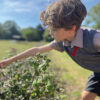by Kim Jackson M.S.S.F.
Klodhoppers (Hove and Haywards Heath)
I am writing this in the middle of the heatwave and it’s hard to imagine, that when the temperature is touching thirty degrees on the thermometer, it will ever rain again! But we are British and we know our British weather. It will rain for days and days in the autumn and winter, and probably most of next spring too!
Most of us will be forced to dig out our wellies for that walk to work or for taking the dog to the park, or for walking the children to school. Most of us will also realise that our children’s wellies have been either chewed by the dog, are split and leaking due to being stored in extreme temperatures in the shed, or are at least two sizes too small for anyone in the family to wear. This causes mass panic when you realise you’re going off camping at the weekend and are likely to need something waterproof on your children’s feet.
It has to be said that due to the variable British climate most children tend to need a pair of Wellington boots all year round. Plus they are often a big favourite with most toddlers who seem to love to wear their wellies whatever the weather.
But what a funny name – ‘wellie’ – where does it come from? How did one of our favourite items of footwear get its name?
It was all down to Arthur Wellesley the first Duke of Wellington. He was the victor at the Battle of Waterloo and a bit of a fashion icon in his day.
Military uniforms, fame and fashion have always been closely linked. Regimental dress uniforms were designed to stand out and impress young men so that they would join up, with the added bonus of attracting the young ladies who admired them in their regalia.
When the French Revolutionary and Napoleonic wars (1792-1815) brought most of Europe into battle, it is hardly surprising that they introduced a lot of military fashion trends into civilian life.
In the 1790s officers in the British Army wore boots called ‘Hessians’, which were named after the German mercenaries who fought alongside the British in the American War of Independence (1775-83). Hessians were made of soft, highly polished calfskin. They were knee high with a curved top, similar to a riding boot, but with a ‘V’ shape, decorated with a tassel, cut into the front.
From the 1790s onwards, ordinary soldiers situated in hot climates began to wear lightweight linen trousers, instead of their normal woollen breeches, as they were cooler and more comfortable. Back home the fashion for wearing these tight-fitting trousers became popular in the 1800s. They were most notably associated with the famous style icon of that day, Beau Brummell.
The problem with the Hessians was the tassel on the front – traditionally designed to be worn with breeches, but now too awkward to fit into the tighter, more fashionable trousers.
At some stage during the early 1800s Arthur Wellesley, then Viscount Wellington, asked his shoemaker, Mr George Hoby of St James’s Street, London, to make a boot which was easier to wear with the new style of trousers. Hoby removed the tassel and cut the boots slightly lower to make them more comfortable for riding.
George Hoby was very proud of his achievement and is reported to have said on the news of the French defeat at Vittoria, “If Lord Wellington had any other bootmaker than myself, he never would have had his great and constant successes; for my boots and prayers bring his lordship out of all his difficulties.”
Even before his great victory over Napoleon at the Battle of Waterloo in 1815, Wellington was already on his way to becoming a fashion icon. By 1813, and the Battle of Vittoria, Wellington’s fame led others to start wearing this new style of long boot. The boots duly became known as ‘Wellingtons’.
These boots were popular with the troops because they were hard wearing for battle yet comfortable for evening wear. The boot leather was treated with wax to make them softer and more waterproof.
Wellington became a well-known figure in politics after Waterloo, becoming Prime Minister in 1828. Political cartoonists used the Duke’s boots and his prominent nose to represent him. By 1830 he was being depicted simply as a Wellington boot with a head (with a rather large nose).
 Wellingtons remained fashionable until the Duke’s death in 1853, but had declined in popularity by 1860 when the ankle boot finally superseded them. Nonetheless they continued to be worn by senior officers in the British Army, doing service in Crimea and the First World War.
Wellingtons remained fashionable until the Duke’s death in 1853, but had declined in popularity by 1860 when the ankle boot finally superseded them. Nonetheless they continued to be worn by senior officers in the British Army, doing service in Crimea and the First World War.
Meanwhile in 1856, the Edinburgh-based North British Rubber Company had started manufacturing Britain’s first rubber or ‘gum’ boots. With the name of the duke still retaining a patriotic pull on consumers, these new boots were soon also renamed Wellingtons in Britain.
Their popularity did not become widespread until the First World War, when in 1916 the company was commissioned to produce millions of pairs as standard winter kit for ordinary soldiers, to prevent ‘trench foot’, a medical condition caused by prolonged exposure to damp.
At the end of the war, soldiers brought these boots home and used them in their daily lives for very practical tasks such as farming, gardening and general wet weather wear. (A century later, music festivals and fashion catwalks are still benefiting from this wartime legacy.)
The North Rubber Company continued to prosper introducing the Green Hunter and Royal Hunter Wellingtons in 1955. The company changed its name to Uniroyal Limited in 1966. More changes took place until eventually four decades later, the Wellington boot production section became Hunter Boot Limited. Hunter wellies have transformed from being a solely practical item to now a very popular fashion brand.
In the 19th century Charles Goodyear invented a vulcanisation process for rubber which some American boot makers used to start making rubber boots.
Hiram Hutchinson saw the potential and shod agricultural workers in France and he bought the patent from Goodyear in 1852. He started a rubber boot company in Montargis called ‘La Compagnie du Caoutchouc Souple’ (The Flexible Rubber Company). He patented a brand of Wellington boots he called ‘A L’Aigle’ or Homage to the Eagle in 1853. The new waterproof boots were quick to become established and sold well within the large rural population. By 1857 the company were hand making 14,000 pairs of boots per day. Now called Aigle, these wellies have become synonymous with quality and with 95% of the Aigle collection still being handcrafted in France.
A couple of words of ‘wellie advice’ for you:
Parents of rural-based children need to be aware that if their children wear their wellies most of the time (if they live on a farm, for example) then the boots will wear out quicker than usual, especially if the children are young and also have ride-on toys and bikes. Except for some of the more premium brands, most Wellington boot manufacturers will only guarantee children’s wellies for a three month period. However, excessive wear and tear can also ‘void’ this guarantee period.
Also, if young children are in the correct size wellies then – generally speaking – they will have grown out of them within three months anyway.
Parents ask us “Is it alright for children to wear wellies all winter?” The simple answer is ‘no’! It is not good for their foot health. Wearing an unstructured item of footwear such as wellie boots all winter allows the foot to spread and become flaccid, therefore it will prove difficult to get some children back into a structured shoe later on. The child will have become used to the loose, floppy feel of a wellie, and will then complain that any shoe ‘feels tight’ even when it is the correct fit. It is also worth remembering that a child’s gait is slightly different when walking in wellies rather than shoes. They tend to drag their feet along in wellies and grip with their toes, as opposed to using a proper heel to toe motion when walking in a fitted shoe.
If you would like advice on wellies, waterproof boots and other suitable footwear for the autumn/winter season, then please come in and ask.
At Klodhoppers we strive to give you our best and honest advice – we won’t tell you a tall tale!
Kim Jackson M.S.S.F.
(Member of the Society of Shoe Fitters)
Klodhoppers (Hove & Haywards Heath)



 There is a reason why we ‘play’ sport – sport has to be about having fun. For some, that pleasure will come from being intensely competitive, for others simply in being part of something bigger than themselves and spending time with their friends, not so much in the pursuit of excellence, but to cement relationships and support networks, to let
There is a reason why we ‘play’ sport – sport has to be about having fun. For some, that pleasure will come from being intensely competitive, for others simply in being part of something bigger than themselves and spending time with their friends, not so much in the pursuit of excellence, but to cement relationships and support networks, to let To begin, sit in easy pose, to promote inner calm. Imagine a balloon gently pulling your head up to sit a little taller, take in three deep breaths, counting to three on each breath in and three on each breath out. For the first few times you practice this with your child count aloud; that way they can then fully concentrate on their breathing. Focusing on the breath will help the mind begin to unwind and relax.
To begin, sit in easy pose, to promote inner calm. Imagine a balloon gently pulling your head up to sit a little taller, take in three deep breaths, counting to three on each breath in and three on each breath out. For the first few times you practice this with your child count aloud; that way they can then fully concentrate on their breathing. Focusing on the breath will help the mind begin to unwind and relax. Start on all fours, hands under shoulders, knees under hips. Cow – inhale and gently drop the belly towards the floor, lift the head and tailbone up towards the ceiling.
Start on all fours, hands under shoulders, knees under hips. Cow – inhale and gently drop the belly towards the floor, lift the head and tailbone up towards the ceiling. Cat – reverse the movement, exhaling deeply and round the spine, tucking the chin in towards the chest. If your child feels happy to do so, ask them to close their eyes as they do this.
Cat – reverse the movement, exhaling deeply and round the spine, tucking the chin in towards the chest. If your child feels happy to do so, ask them to close their eyes as they do this. Sit with your feet and heels touching. You can introduce some very gentle movement with the breath by lifting the knees up and down. You can, if you feel it is right for your child, encourage them to close their eyes and imagine they are a beautiful butterfly fluttering round their favourite park or place in nature.
Sit with your feet and heels touching. You can introduce some very gentle movement with the breath by lifting the knees up and down. You can, if you feel it is right for your child, encourage them to close their eyes and imagine they are a beautiful butterfly fluttering round their favourite park or place in nature. This is extremely self-soothing and helps to promote digestion, relieves stress and helps to calm the mind.
This is extremely self-soothing and helps to promote digestion, relieves stress and helps to calm the mind. This is another self-soothing posture. It increases circulation to the head and releases tension in the neck and back. Allow for the knees to come to the chest and clasp arms around the shin area of the leg. Gently rock side to side which gives a gentle bedtime massage to the spine.
This is another self-soothing posture. It increases circulation to the head and releases tension in the neck and back. Allow for the knees to come to the chest and clasp arms around the shin area of the leg. Gently rock side to side which gives a gentle bedtime massage to the spine.

 Wellingtons remained fashionable until the Duke’s death in 1853, but had declined in popularity by 1860 when the ankle boot finally superseded them. Nonetheless they continued to be worn by senior officers in the British Army, doing service in Crimea and the First World War.
Wellingtons remained fashionable until the Duke’s death in 1853, but had declined in popularity by 1860 when the ankle boot finally superseded them. Nonetheless they continued to be worn by senior officers in the British Army, doing service in Crimea and the First World War. Safety
Safety Meet new friends
Meet new friends










